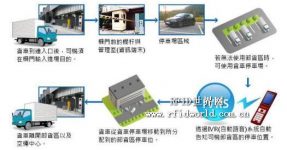
Asian Air Transport Center AAT takes the lead in introducing RFID truck control system
[ad_1]
AAT took the lead in introducing a truck control system combined with RFID, which was highly praised in the industry. In the future, we will consider introducing this system into other cargo stations as well, and actively introduce our application performance to the outside world.
Import background
This system was introduced when the new cargo station was installed to cope with the increasing volume of cargo
The air cargo import and export terminal of Hong Kong International Airport is operated by the Asian Shipping Center (hereinafter AAT), and its cargo volume ranks second in Hong Kong. In order to efficiently manage the increasing volume of cargo, AAT introduced a truck control system combined with RFID when setting up the new cargo station.
The company further links the freight management system and the truck control system to provide comprehensive services such as logistics management for major airlines and processing of cargo customs inspection documents at the Hong Kong International Airport.
The new cargo terminal (Air Cargo Terminal No. 2) completed in 2007 has a height of 4 floors. In a year, about 1.5 million tons, that is, about 30% of Hong Kong International Airport’s cargo, are processed here.
Generally speaking, the peak moments of logistics are mostly concentrated at night. Therefore, in order to allow goods, especially air freight import and export goods, to be shipped reliably and quickly, and to shorten the time the goods are parked at the airport, the system must try to efficiently channel trucks in and out.
In the highly competitive industry, the industry must keep track of the location of the goods and the progress of the goods loading, and inform customers in real time to improve customer satisfaction.
Due to the different sizes and types of trucks parked in the cargo terminal, the industry must try to monitor vehicles simultaneously and issue warnings to vehicles that do not comply with order, such as diagonal parking, in order to achieve effective use of parking space. In addition, it is also necessary to establish a complete safety mechanism that can monitor drivers and trucks to prevent illegal hiding of dangerous goods or intrusion by unauthorized persons.
In the past, the industry had used smart card automatic door systems to control the operation of cargo stations. However, the automated control and management of entrances and exits has allowed the personnel expenses for monitoring and management of the business to increase instead of decreasing, and it is impossible to realize the simultaneous control of inbound and outbound. Therefore, in order to improve vehicle guidance efficiency and adaptability, the industry decided to introduce an RFID system.
The introduction process provides comprehensive and flexible support in the field of advanced technology, which is a key factor for ATT to choose NEC
When introducing a truck control system that incorporates RFID technology, ATT not only hopes that the system is easy to use and can be used effectively, but also must have a reliable safety control mechanism that meets the needs of international cargo transportation. After various reviews, AAT selected NEC, which has the actual performance of all countries in the world, as the development partner of the new system.
I was a little uneasy about the large-scale changes in the system architecture. After accepting proposals from several companies that provide RFID solutions, NEC was selected as the system construction partner because NEC has extensive experience and performance in advanced technology, and the issues raised by AAT are also the same. Once an appropriate response was given, the doubts and anxiety in the heart disappeared.
In addition, NEC provides a complete set of overall solutions with its huge organizational power, rather than a single part or tool; and with a high degree of technical strength, it is committed to meeting the needs of AAT, which deserves to be highly praised and praised (Nelson Lee’s)
System summary
Replace the previous smart card system with RFID
The application process of the new truck control system is as follows:
First, register the data of the vehicle and driver that can enter and exit in the system, and then install the RFID tag that loads the data on the windshield of the vehicle. When the goods are loaded on the truck, the truck control system and the truck management system will compare the vehicle ID and other data, and report the comparison result to the headquarters. The entrance gate of the freight station is also equipped with a door-type RFID card reader, and the outbound truck needs to be automatically identified here. Afterwards, the truck control system will automatically detect the location of the cargo delivery and display the most suitable parking location for the truck on the screen for efficient evacuation. When there is a vehicle that is not parked in a designated location or parked improperly, the system will send out an alarm on the spot or send a warning message to the driver’s pre-registered mobile phone number to request it to be parked at the appropriate designated location again.
The program design in this system is in charge of NEC Hong Kong; the RFID card reader and electronic label adopt the products of American Alien Technology (UHF standard specification). As for KIOSK, it is produced by NEC Hong Kong’s Chinese partner company.

System overview diagram (vehicle guidance process)
Introduction results and future prospects In addition to improving the efficiency of truck guidance, the industry can use this system to strengthen the safety control mechanism, reduce personnel costs, and improve customer satisfaction
Since vehicles entering and exiting stations need to be registered and approved in advance, the system’s mechanism of comparing vehicle and cargo information when loading goods can improve the efficiency of truck guidance management and parking space utilization.
After the introduction of this system, the automatic identification mechanism at the entrance and exit of the cargo station reduced the time for trucks to enter and exit the station by about 7 or 8 minutes compared with the past, which greatly improved customer satisfaction.
This real-time automatic monitoring system can automatically track the location of trucks, strengthen the safety control mechanism, and can be used for other effective applications. In addition, after the introduction of this system, the industry does not need to hire security personnel at the entrance and exit of the freight station, saving up to 8 million Hong Kong dollars in personnel expenses.
The truck control system introduced this time is an advanced technology system that combines RFID technology.
Thanks to this, AAT was awarded the 2007 Hong Kong ICT Awards (Hong Kong Information and Communication Technology Awards) “Best Ubiquitous Network” Bronze Award and “Best Business System (Application) Award (Best Business) Application) Merit Award”. And many other awards, to achieve an excellent publicity effect. In the future, we will also consider introducing this system in other cargo stations, and share AAT’s system experience with the outside world.
Message from the person in charge of the NEC system Since this case is the first time that NEC has applied the RFID solution to the truck control at the airport cargo terminal, it can be said that it has experienced many frustrations during the introduction process before actual use.
In particular, considerable effort has been placed on the setting of the reading position of the RFID tag. For example, the width, height, and length of cargo vehicles vary from ordinary passenger cars to 10m large trucks. Therefore, when the system is built, the installation position of the RFID tag for the car must be adjusted first, and the dead angle area generated by the small car when the large vehicle passes by is as small as possible.
In addition, in order to prevent the driver from parking the truck in the parking bay and the parking bay without stopping the vehicle at the designated location, NEC has been committed to developing a system that can detect the complex movement of the vehicle in time during the system introduction period. The method is to install the antenna in an appropriate place, use multiple benchmarks to calculate the installation position of the label, and develop a set of sensing software combined with a comparison algorithm. After many attempts and efforts, and the problems were solved one by one in order, this system was finally developed.
When the system was built, AAT proposed “hoping to reduce the waiting time of trucks from the original 13 minutes to 5 minutes”, “utilizing the truck workbench to the extreme”, and “the accuracy of the data collected by the system” It can be as high as 99% and fully automated” and “hope to be the first air cargo terminal in Hong Kong to adopt RFID technology” and other requirements. NEC then used its own technology to sincerely respond to customer needs one by one.
In the future, NEC will strive to provide AAT with more complete services, and will continue to make proposals using its accumulated experience and performance.
[ad_2]




